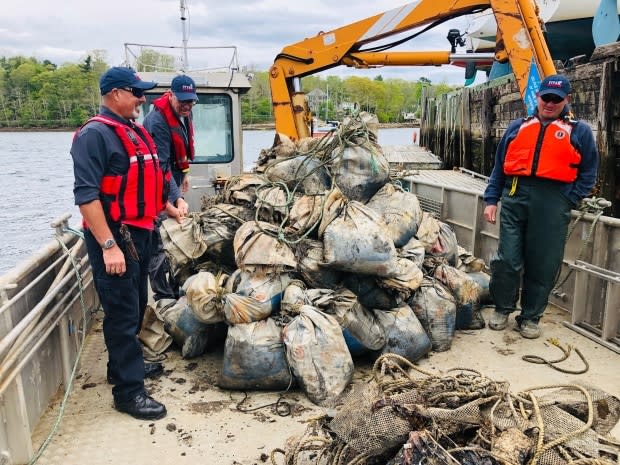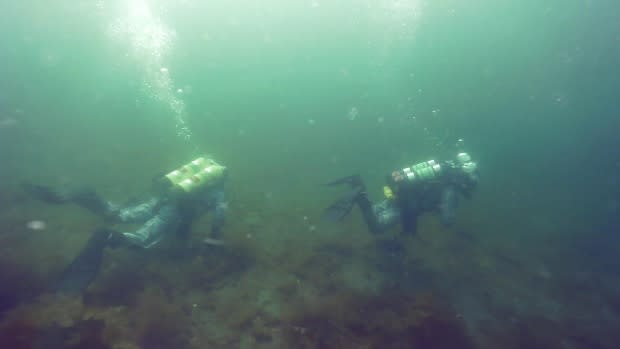Underwater hunters discover a Titanic-like mess of decades-old fishing garbage
During an underwater hunt not far from his seaside home in Mahone Bay, N.S., shipwreck diver Tony Sampson and his crewmates aboard a barge found "the mother lode" last week.
But it wasn't treasure. It was another man's trash — abandoned or lost fishing equipment, called ghost gear.
"Looming out of the darkness came these images, it almost looked like the Titanic," Sampson, who works for the company Titan Maritime, said with a chuckle.
In the cloudy water, he found himself exploring three kilometres of plastic fishing lines weighed down by 50 bags filled with sand and gravel, resembling the stanchions of the famous sunken ship.
It wasn't the Titanic wreckage, but it was an immense amount of ghost gear spread over a 600-metre watery grave.

"Wouldn't it have been nice to find a shipwreck laden with gold? Of course, it would have," he said as he pointed to four tonnes of stinky gear they hauled up and piled onto the boat.
It might be rubbish but its removal is a priceless contribution to the protection of endangered North Atlantic right whales, whose numbers are dwindling due to fishing gear entanglements.
In the coastal waters off Nova Scotia's South Shore, fishing gear can also harm endangered leatherback turtles migrating to their summer homes in Cape Breton and great white sharks.
Land was still in sight when the crew pulled up the ghost gear. And it wasn't in very deep water, only about 15 metres. If it broke free in a storm, it could have threatened recreational boaters.
"If a boat travelling at speed got caught up in that, it would come to a very bad end," Sampson said.

Last July, the Department of Fisheries and Oceans and the Canadian Coast Guard spent three days hauling lost fishing gear from the Gulf of St. Lawrence. Dubbed Operation Ghost, crews netted nine kilometres of rope and 101 snow crab traps.
But that's just a drop in a vast, polluted ocean.
Every year, 640,000 tonnes of fishing gear is left to litter Canada's oceans. Last year, DFO announced it would spend $8.3 million over two years for ghost gear retrieval, disposal and innovative gear technology.
But in the first year, all of the program is tapped out. In a statement, the press secretary to Fisheries Minister Bernadette Jordan, Jane Deeks, said 82 proposals valued at $39 million came in. DFO awarded funding to 26 Canadian and international projects.
Titan Maritime didn't receive any funding despite meeting the program requirements, said Allen Munroe, the company's director of business development. The ex-navy commander said the team had no choice but to help.
"I equate it to — you hear a mayday when you're at sea," said Munroe. "You're bound as a mariner to go and respond, and in this case we're bound to respond as well."

To support its pitch for funding, the company spoke to fishermen from Yarmouth in southern Nova Scotia to Cape Breton and found they were quick to reveal their secrets. Discarded equipment also threatens to snarl up traps, nets and lines still in use.
"They're very honest, and they showed us where a lot of it is, and they said millions of tonnes. So it's going to take a long, long time to get the ocean scoured," said Munroe.
Titan's hope is the federal program will be renewed.
Deeks said the department is optimistic about the interest in the program, but is not in a position to commit to additional funding.

Ken deBoer customized a ROV, known as an underwater drone, specifically for this quest.
But this was no fishing expedition. They had longitude and latitude numbers provided by the Canadian Hydrographic Service leading them to the spot, Sampson said.
Between 2011-2017, the service gathered data from high resolution multi-beam echo-sounders, airborne lidar bathymetry and remote sensing imagery to create a new navigational chart of the Mahone Bay-area, southeast of Oak Island, said Stephen Parsons, a geomatics engineer at CHS.
Parsons said the service provided Titan Maritime with "detailed images, created during the processing of the hydrographic data, showed possible manmade objects such as moorings and lines."
The information was so accurate that as soon as the ROV was lowered and turned left, the hunt was over. DeBoer hovered the machine in front of the find and gathered the crew of four.
"Everybody came over and huddled around the screen, and five highs going around on the barge, and it was fun," said deBoer.
Even with a crane and a winch, it took the crew an entire day to haul up the ghost fishing gear.
Ryan Mosher, the skipper, said it took lots of work to unravel three kilometres of rope attached to polystyrene buoys and sand bags. Lines were cut and tied to cleats so the bags wouldn't be lost again.
"We had strings all over the boat," he said.

Based on clues from the ghost gear and the marine life growing on it, it's estimated the mess had laid on the bottom of the sea for between 20 to 40 years.
But this garbage might have value, after all. Titan is partnering with recycling company Goodwood Plastic to repurpose ocean plastic into building materials.
Sampson is glad to have salvaged so much stuff from the sea, his backyard.
"This here, to pull this off the bottom, it not only gives us a warm sense but it is doing something for the environment here as well," said Sampson. "It feels great, it really was a win."
MORE TOP STORIES

 Yahoo Movies
Yahoo Movies 